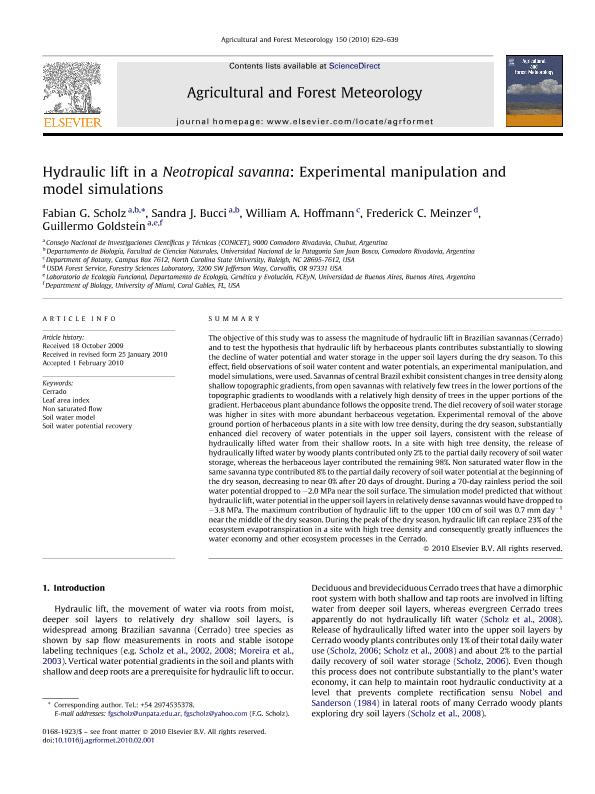Artículo
Hydraulic lift in a Neotropical savanna: Experimental manipulation and model simulations
Scholz, Fabian Gustavo ; Bucci, Sandra Janet
; Bucci, Sandra Janet ; Hoffmann, William A.; Meinzer, Frederick C.; Goldstein, Guillermo Hernan
; Hoffmann, William A.; Meinzer, Frederick C.; Goldstein, Guillermo Hernan
 ; Bucci, Sandra Janet
; Bucci, Sandra Janet ; Hoffmann, William A.; Meinzer, Frederick C.; Goldstein, Guillermo Hernan
; Hoffmann, William A.; Meinzer, Frederick C.; Goldstein, Guillermo Hernan
Fecha de publicación:
04/2010
Editorial:
Elsevier Science
Revista:
Agricultural And Forest Meteorology
ISSN:
0168-1923
Idioma:
Inglés
Tipo de recurso:
Artículo publicado
Clasificación temática:
Resumen
The objective of this study was to assess the magnitude of hydraulic lift in Brazilian savannas (Cerrado) and to test the hypothesis that hydraulic lift by herbaceous plants contributes substantially to slowing the decline of water potential and water storage in the upper soil layers during the dry season. To this effect, field observations of soil water content and water potentials, an experimental manipulation, and model simulations, were used. Savannas of central Brazil exhibit consistent changes in tree density along shallow topographic gradients, from open savannas with relatively few trees in the lower portions of the topographic gradients to woodlands with a relatively high density of trees in the upper portions of the gradient. Herbaceous plant abundance follows the opposite trend. The diel recovery of soil water storage was higher in sites with more abundant herbaceous vegetation. Experimental removal of the above ground portion of herbaceous plants in a site with low tree density, during the dry season, substantially enhanced diel recovery of water potentials in the upper soil layers, consistent with the release of hydraulically lifted water from their shallow roots. In a site with high tree density, the release of hydraulically lifted water by woody plants contributed only 2% to the partial daily recovery of soil water storage, whereas the herbaceous layer contributed the remaining 98%. Non saturated water flow in the same savanna type contributed 8% to the partial daily recovery of soil water potential at the beginning of the dry season, decreasing to near 0% after 20 days of drought. During a 70-day rainless period the soil water potential dropped to -2.0 MPa near the soil surface. The simulation model predicted that without hydraulic lift, water potential in the upper soil layers in relatively dense savannas would have dropped to -3.8 MPa. The maximum contribution of hydraulic lift to the upper 100 cm of soil was 0.7 mm day-1 near the middle of the dry season. During the peak of the dry season, hydraulic lift can replace 23% of the ecosystem evapotranspiration in a site with high tree density and consequently greatly influences the water economy and other ecosystem processes in the Cerrado.
Archivos asociados
Licencia
Identificadores
Colecciones
Articulos(IEGEBA)
Articulos de INSTITUTO DE ECOLOGIA, GENETICA Y EVOLUCION DE BS. AS
Articulos de INSTITUTO DE ECOLOGIA, GENETICA Y EVOLUCION DE BS. AS
Citación
Scholz, Fabian Gustavo; Bucci, Sandra Janet; Hoffmann, William A.; Meinzer, Frederick C.; Goldstein, Guillermo Hernan; Hydraulic lift in a Neotropical savanna: Experimental manipulation and model simulations; Elsevier Science; Agricultural And Forest Meteorology; 150; 4; 4-2010; 629-639
Compartir
Altmétricas



